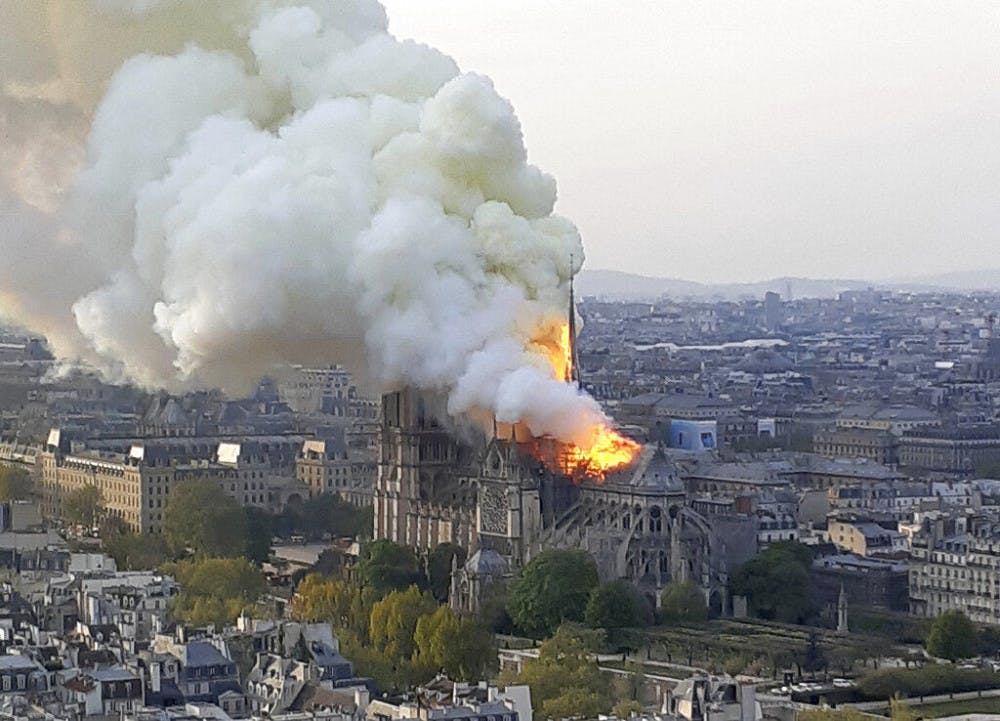One week ago today, the world was rocked by the news that a symbol, a monument to creativity and a cathedral were all burning: Notre Dame Cathedral was on fire.
If you’re wondering what the fuss is about regarding this medieval church, allow me to explain. Notre Dame Cathedral, formally known as Notre-Dame de Paris, “Our Lady of Paris” in French. The cathedral is a Gothic style church on the Île de la Cité in Paris, France. Gothic refers to a style of architecture characterized by grand height, flying buttresses for support, pointed arches and a generally ornate and luxurious appearance. In fact, this appearance is part of what makes Notre Dame so significant. Though far from the only example, Notre Dame is probably the most well-known example of Gothic architecture in the world. Gothic architecture had its heyday from the mid-12th century until the 16th century, contributing to a flourishing of art even before the Renaissance. Gothic architecture still resonates today. Take a walk around UF’s Historic District and look at the University Auditorium to see it. With its arched windows and exterior buttresses, it is an example of Gothic architecture on a much smaller scale.
In addition, Notre Dame is a symbol of both Paris and the whole nation of France. While other symbols like the Arc de Triomphe and the Eiffel Tower reflect France’s more recent history, Notre Dame is the most famous symbol of France’s medieval era. While the medieval era has often been derisively referred to as the “Dark Ages,” it was also when the nation of France as we know it today began to take shape. The same king who developed Notre Dame, Louis VII, also pushed for the centralization of France, which continued under Louis’s son King Philip II. As France moved from the feudal era to the Renaissance and eventually became the most powerful state on the European continent, Notre Dame stood on the banks of the Seine as a monument to both France’s past and its great hope for the future. Notre Dame’s 13 million visitors a year is just one testament to its continuing relevance.
While Notre Dame’s fire is a big loss, it’s not the first time the historic cathedral suffered damage. Notre Dame was desecrated during the French Revolution, and before Victor Hugo published his novel “The Hunchback of Notre Dame,” the church had fallen into disrepair. Hugo’s novel, however, reignited public interest in Notre Dame, leading the French government to order a major restoration of the cathedral. Just like Victor Hugo led to the first major restoration of Notre Dame, this fire brought the Gothic structure into the public consciousness, inspiring renewed interest in the cathedral and helping to raise the funds for a new restoration.
In fact, Notre Dame was already undergoing a renovation at the time of the fire. However, this effort had only raised $6.8 million of the $169 million that was needed. In the wake of the fire, major companies like Disney have pledged millions of dollars for the restoration, and billionaires like François-Henri Pinault, a fashion mogul and husband of actress Salma Hayek, and Bernard Arnault, the richest man in France and CEO of the luxury goods company behind brands like Louis Vuitton, have also donated to the reconstruction. Altogether, almost $800 million dollars was raised for Notre Dame’s restoration in just a few days.
Perhaps there’s a silver lining to all this. People are now talking about Notre Dame. It’s all over the news, and everyone from regular folk to celebrities is showing their support, whether through words or through donations. While it’s unfortunate it takes a devastating fire to get people talking about a historic church and a French symbol, we might as well appreciate it while we can.
Jason Zappulla is a UF history junior. His column appears on Mondays.
In this image made available on Tuesday April 16, 2019 flames and smoke rise from the blaze at Notre Dame cathedral in Paris, Monday, April 15, 2019. An inferno that raged through Notre Dame Cathedral for more than 12 hours destroyed its spire and its roof but spared its twin medieval bell towers, and a frantic rescue effort saved the monument's "most precious treasures," including the Crown of Thorns purportedly worn by Jesus, officials said Tuesday. (AP Photo/Cedric Herpson)






